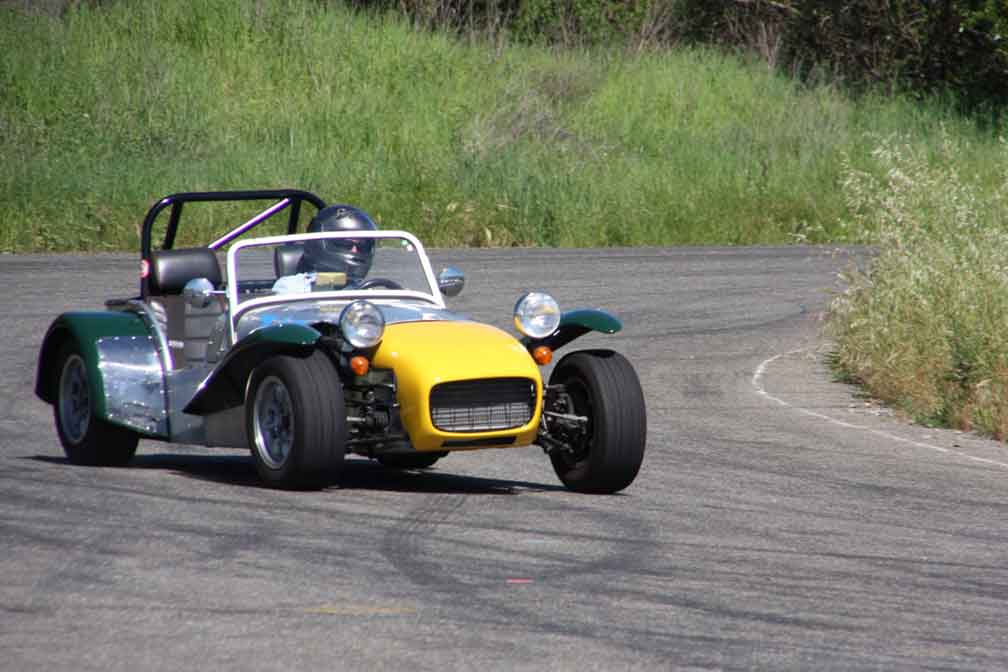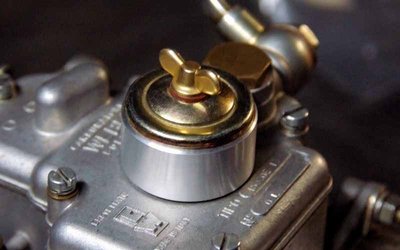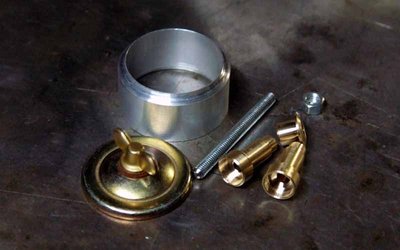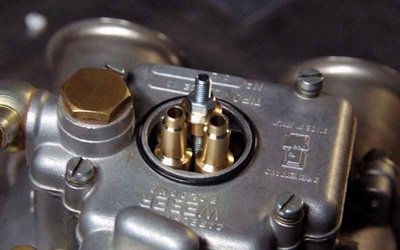Weber Carb Flooding During & After Cornering On Race Track.
41 posts
• Page 1 of 3 • 1, 2, 3
Hi Guys.
This is not entirely lotus, but Weber Carb related.
I have a mate who races his hot little sprite which is fitted with a cooper S1375 engine that breaths through a 45mm DCOE side draft Weber.
Fuel delivery is via pressure controlled electric pump.
On certain race track corners (mainly right hand) the engine bogs down and the webers splutter and spit, then it clears, regains composure, comes to life revving clean and hard down the straight.
The weber experts say that the fuel (under hard braking and high cornering Gs) is sloshing about in the fuel bowl with some of the splashing fuel drowning the air correctors.
Said Weber experts suggested machining some risers to fit over the air correctors/main jet assembly.
Which also requires a small alloy surround or riser housing to enclose things.
An extended threaded rod is also required for the standard cap to screw onto, and a small retaining disc to hold and prevent the risers from vibrating loose and falling off the jet assembly.
If any of the Weber experts are reading this, can you tell me if this will work or not, as we are just going on what someracing guys are saying here in OZ.
I have never experienced this type of phenomena with my twin cam engine while driving the elan pretty damn hard.
As the pic shows, the parts have been machined, and all that is required is to fit and do another track test day, the mystery continues.
If you have track experience with webers with this annoying problem I would be interested to here your thoughts.
Ceejay
This is not entirely lotus, but Weber Carb related.
I have a mate who races his hot little sprite which is fitted with a cooper S1375 engine that breaths through a 45mm DCOE side draft Weber.
Fuel delivery is via pressure controlled electric pump.
On certain race track corners (mainly right hand) the engine bogs down and the webers splutter and spit, then it clears, regains composure, comes to life revving clean and hard down the straight.
The weber experts say that the fuel (under hard braking and high cornering Gs) is sloshing about in the fuel bowl with some of the splashing fuel drowning the air correctors.
Said Weber experts suggested machining some risers to fit over the air correctors/main jet assembly.
Which also requires a small alloy surround or riser housing to enclose things.
An extended threaded rod is also required for the standard cap to screw onto, and a small retaining disc to hold and prevent the risers from vibrating loose and falling off the jet assembly.
If any of the Weber experts are reading this, can you tell me if this will work or not, as we are just going on what someracing guys are saying here in OZ.
I have never experienced this type of phenomena with my twin cam engine while driving the elan pretty damn hard.
As the pic shows, the parts have been machined, and all that is required is to fit and do another track test day, the mystery continues.
If you have track experience with webers with this annoying problem I would be interested to here your thoughts.
Ceejay
Live your dream-wear your passion.
http://elantrikbits.com/lotus-elan-blog/
http://elantrikbits.com/lotus-elan-blog/
- ceejay
- Fourth Gear

- Posts: 623
- Joined: 27 Mar 2007
Hi Col
I have seen a few competition cars over the years fitted with these mods but I have never personally experienced the problem.
When I look at the float design and the centre well design cornering should not result in flooding the well as long as the float does not jam under high G loads.
I have seen a few competition cars over the years fitted with these mods but I have never personally experienced the problem.
When I look at the float design and the centre well design cornering should not result in flooding the well as long as the float does not jam under high G loads.
-

rgh0 - Coveted Fifth Gear

- Posts: 8829
- Joined: 22 Sep 2003
Hi Rohan
That was my thoughts to, but I am no guru where carbs are concerned.
I actually doubted what was being bandied around re the riser tubes, so the only thing was to whiz up
some parts on the lathe and fit them back on the little sprite and see what happens.
It may we be what you said... the float jamming in the fuel bowl. The weber on the engine is the new Spanish made carb not the original Italian weber.
Col
That was my thoughts to, but I am no guru where carbs are concerned.
I actually doubted what was being bandied around re the riser tubes, so the only thing was to whiz up
some parts on the lathe and fit them back on the little sprite and see what happens.
It may we be what you said... the float jamming in the fuel bowl. The weber on the engine is the new Spanish made carb not the original Italian weber.
Col
Live your dream-wear your passion.
http://elantrikbits.com/lotus-elan-blog/
http://elantrikbits.com/lotus-elan-blog/
- ceejay
- Fourth Gear

- Posts: 623
- Joined: 27 Mar 2007
Ceejay,
The problem you describe is similar (but different) to what Dellorto DHLA carbureted Turbo Esprits would experienced when tossed about. Fuel in the float bowl would splash up on top of the jet pedestal and flood the air correctors. Coming out of a quick series of turns (or during an autocross run), the engine would suddenly chug and sputter, belch black smoke, and almost quit. Then it would clear it's throat and all would be normal again.
Those carbs were sealed and pressurized for the blow-thru turbo application, and had boost pressure lines (a pressurized air source) connected to special versions of the small jet cover. There's a partition wall inside the jet cover, between the air inlet and the jets. Lotus Cars USA (LCU) would drill holes thru that wall, aimed right at the air correctors. The air blast would blow any fuel that landed on the pedestal away from the jets. Problem solved.
Okay, the Webers in question aren't pressurized, and don't have an air source at that point. But the logic of the fix being made is similar. Keep the fuel that splashes up on top of the jet pedestal away from the air correctors. The Weber solution being tried uses dams instead of an air jet, but the end goal is the same. I've not tried this solution, but I suspect it will help.
*~*~*
Most Weber DCOE and Dellorto DHLA installations have the carbs mounted crosswise to the car's centerline. The float bowl is designed to manage the fuel slosh primarily for cornering with the carbs in that position. Also, the floats are hinged and hung the way they are to best maintain the fuel level under cornering G's when mounted sideways to the car.
In the Mini, the DCOE is rotated 90 degrees from it's design position. That may be a good part of why your friend is experiencing problems in his Mini that you don't encounter in your Lotus.
Regards,
Tim Engel
Lotus Owners Oftha North (LOON)
The problem you describe is similar (but different) to what Dellorto DHLA carbureted Turbo Esprits would experienced when tossed about. Fuel in the float bowl would splash up on top of the jet pedestal and flood the air correctors. Coming out of a quick series of turns (or during an autocross run), the engine would suddenly chug and sputter, belch black smoke, and almost quit. Then it would clear it's throat and all would be normal again.
Those carbs were sealed and pressurized for the blow-thru turbo application, and had boost pressure lines (a pressurized air source) connected to special versions of the small jet cover. There's a partition wall inside the jet cover, between the air inlet and the jets. Lotus Cars USA (LCU) would drill holes thru that wall, aimed right at the air correctors. The air blast would blow any fuel that landed on the pedestal away from the jets. Problem solved.
Okay, the Webers in question aren't pressurized, and don't have an air source at that point. But the logic of the fix being made is similar. Keep the fuel that splashes up on top of the jet pedestal away from the air correctors. The Weber solution being tried uses dams instead of an air jet, but the end goal is the same. I've not tried this solution, but I suspect it will help.
*~*~*
Most Weber DCOE and Dellorto DHLA installations have the carbs mounted crosswise to the car's centerline. The float bowl is designed to manage the fuel slosh primarily for cornering with the carbs in that position. Also, the floats are hinged and hung the way they are to best maintain the fuel level under cornering G's when mounted sideways to the car.
In the Mini, the DCOE is rotated 90 degrees from it's design position. That may be a good part of why your friend is experiencing problems in his Mini that you don't encounter in your Lotus.
Regards,
Tim Engel
Lotus Owners Oftha North (LOON)
- Esprit2
- Fourth Gear

- Posts: 561
- Joined: 02 Apr 2008
Hi Tim
Thank you for your detailed explanation on weber jet/air corrector fuel flooding phenomena, I will show
him what you have said.
The cooper engine is installed in a Healey sprite so is in line with the car (North-South) not (East West) as it normally would be.
We will try the risers I machined, and take on board what you have said.
Thanks again.
Col.
Thank you for your detailed explanation on weber jet/air corrector fuel flooding phenomena, I will show
him what you have said.
The cooper engine is installed in a Healey sprite so is in line with the car (North-South) not (East West) as it normally would be.
We will try the risers I machined, and take on board what you have said.
Thanks again.
Col.
Live your dream-wear your passion.
http://elantrikbits.com/lotus-elan-blog/
http://elantrikbits.com/lotus-elan-blog/
- ceejay
- Fourth Gear

- Posts: 623
- Joined: 27 Mar 2007
I just did a post on the same problem before `i'd seen yours - except in my case it seems to be starving of fuel rather than flooding. It also seemed to improve slightly with increased float level gap (i.e. higher fuel level in the carbs).
I'm frustrated that I can't find any real Weber experts around here.
Paul
I'm frustrated that I can't find any real Weber experts around here.
Paul
Turning money into noise!
- toomspj
- Second Gear

- Posts: 192
- Joined: 04 Dec 2007
G'Day Paul.
It seems there is always a niggle to solve with carburation, and webers are not alone there, true weber esperts are hard to find, and the current crop of people found in most local areas are mostly EFI experts. Good luck with your search, we lost our local Weber expert (Clive) due to a brain tumor many years ago, and have not found anyone who comes near the expertise that he had.
Hopefully you will be able to cure the fuel starvation.
BTW, I enjoy watching the videos you have on youtube (If you the same P Tooms).
Col.
It seems there is always a niggle to solve with carburation, and webers are not alone there, true weber esperts are hard to find, and the current crop of people found in most local areas are mostly EFI experts. Good luck with your search, we lost our local Weber expert (Clive) due to a brain tumor many years ago, and have not found anyone who comes near the expertise that he had.
Hopefully you will be able to cure the fuel starvation.
BTW, I enjoy watching the videos you have on youtube (If you the same P Tooms).
Col.
Live your dream-wear your passion.
http://elantrikbits.com/lotus-elan-blog/
http://elantrikbits.com/lotus-elan-blog/
- ceejay
- Fourth Gear

- Posts: 623
- Joined: 27 Mar 2007
I have joined this forum to participate in this specific question. And, hopefully, the answer. I see that no one has said whether of not the fuel dam worked. I have a Westfield 7 pre-lit Kent cross flow with a pair of DCOE 40s, and I am having the problem first described, except that I am also having trouble catching fire, which has now happened 5 times during extended right hand corning in Auto-X. I have replaced most of my fuel system, use a Carter centrifugal pump limited to 2 3/4lb w/gauge on firewall. My fuel cell is mounted with the pick up centralized though it does let out on the left side. I have rebuilt my carburetors with poor results, and then worked hands on with two different credentialed experts with continued poor results. So I bought brand new carburetors which I installed last week. I went to the track yesterday and had trouble resulting in fire twice in 6 runs. The first toasted my third set of air cleaners, RamAIr foam, and the second appeared to be burning on the manifold side of the carbs, which I think to be sloshed fuel delivered by centrifugal force.
I want to know if the jet enclosure dam worked, and whether anyone else has (successfully) dealt with this issue recently. Both my sets of carbs are Spanish 151's.
Thank you,
Bruce
Here's a shot of me yesterday, probably not yet on fire:

I want to know if the jet enclosure dam worked, and whether anyone else has (successfully) dealt with this issue recently. Both my sets of carbs are Spanish 151's.
Thank you,
Bruce
Here's a shot of me yesterday, probably not yet on fire:

- mojoluthier
- New-tral
- Posts: 9
- Joined: 17 Apr 2016
Looks like this forum is a bit slow! I am posting this a year and some after asking for a follow-up on the Weber fix the OP suggested, and nada. Oh well. My car has been parked for a year now, and I have it up for sale on local CL. On the street it is flawless, but that's not what I bought it for.
- mojoluthier
- New-tral
- Posts: 9
- Joined: 17 Apr 2016
Bruce,
The problem originally discussed in this thread had to do with fuel splashing up on top of the jet pedestal, entering the Air Correctors, and flooding the engine. The engine runs poorly, boggs down, or even stalls, but it doesn't pee it's pants.
You're experiencing excess fuel running out of the carbs to the the point of starting engine bay fires. You're not going to get that volume of fuel from splash on the jet pedestal. There's something else going on in your carbs. More of a flowing leak than intermittent rich/ flooding mixture. Apples and oranges.
Are you running air horns? If so, what kind? The correct Weber air horns include a spigot sleeve that slips into the carb's throat and pinches both the auxiliary venturi and the choke in place. When the air horn is tightened down, it clamps the aux. ventury & choke in place.
If Dellorto-style, flange-mounted air horns without the sleeve are used on Weber DCOEs, then the aux. venturi & choke will be loose. That can lead to fuel leaks.
Another possibility involves the throttle shaft cover plate between the two throats, on the mounting flange end. The early stock cover is solid (no holes) steel, mounted with a gasket and secured with two screws. The seal is good enough that vacuum leaks can draw fuel into the chamber behind the cover. The fuel can leak out along the mounting flange side of the carbs. The solution is to drill a hole through the cover to vent it and prevent vacuum build-up. Just a hole, no filter is required. New replacement covers have the vent hole from the factory. Go to an online Weber parts dealer, like Eurocarb led, and look up a picture of one for reference about where to place the hole. It's not critical. High on the cover, and avoid internal bosses/ flanges that might otherwise block the hole.
What is the fuel pressure at the carb inlets. Webers like 1.5 to 2.5 psi. Any more than that (and many electric pumps run more than 6 psi) can over power the float-operated inlet valve. Resulting flooding could be significant enough to cause fuel to flow out the carb inlets into the filter air box, or flow down the throat and possibly leak out past the soft mounts. If the pressure is high, fit an inline adjustable fuel pressure regulator as close to the carb inlets as possible.
Along the same line of thinking, even with correct fuel pressure, a faulty inlet valve, a sinking/ heavy float, incorrect float setting, or combinations can also result in over-filling/ flooding the float chamber.
IMHO, chasing the air corrector extensions is barking up the wrong tree. It may prove advantageous for an auto crosser, but for another reason. But for fuel flowing out of the carb's sufficient to start fires, you need to be looking into leak sources, not minor mixture annoyances.
If you're selling the Seven because it's time to move on, go for it. But if you're selling it out of frustration due to not being able to cure the fuel leak problem, consider keeping the car and investing in a little shop time with a pro who 'understands' Weber DCOEs.
Good Luck,
Tim Engel
The problem originally discussed in this thread had to do with fuel splashing up on top of the jet pedestal, entering the Air Correctors, and flooding the engine. The engine runs poorly, boggs down, or even stalls, but it doesn't pee it's pants.
You're experiencing excess fuel running out of the carbs to the the point of starting engine bay fires. You're not going to get that volume of fuel from splash on the jet pedestal. There's something else going on in your carbs. More of a flowing leak than intermittent rich/ flooding mixture. Apples and oranges.
Are you running air horns? If so, what kind? The correct Weber air horns include a spigot sleeve that slips into the carb's throat and pinches both the auxiliary venturi and the choke in place. When the air horn is tightened down, it clamps the aux. ventury & choke in place.
If Dellorto-style, flange-mounted air horns without the sleeve are used on Weber DCOEs, then the aux. venturi & choke will be loose. That can lead to fuel leaks.
Another possibility involves the throttle shaft cover plate between the two throats, on the mounting flange end. The early stock cover is solid (no holes) steel, mounted with a gasket and secured with two screws. The seal is good enough that vacuum leaks can draw fuel into the chamber behind the cover. The fuel can leak out along the mounting flange side of the carbs. The solution is to drill a hole through the cover to vent it and prevent vacuum build-up. Just a hole, no filter is required. New replacement covers have the vent hole from the factory. Go to an online Weber parts dealer, like Eurocarb led, and look up a picture of one for reference about where to place the hole. It's not critical. High on the cover, and avoid internal bosses/ flanges that might otherwise block the hole.
What is the fuel pressure at the carb inlets. Webers like 1.5 to 2.5 psi. Any more than that (and many electric pumps run more than 6 psi) can over power the float-operated inlet valve. Resulting flooding could be significant enough to cause fuel to flow out the carb inlets into the filter air box, or flow down the throat and possibly leak out past the soft mounts. If the pressure is high, fit an inline adjustable fuel pressure regulator as close to the carb inlets as possible.
Along the same line of thinking, even with correct fuel pressure, a faulty inlet valve, a sinking/ heavy float, incorrect float setting, or combinations can also result in over-filling/ flooding the float chamber.
IMHO, chasing the air corrector extensions is barking up the wrong tree. It may prove advantageous for an auto crosser, but for another reason. But for fuel flowing out of the carb's sufficient to start fires, you need to be looking into leak sources, not minor mixture annoyances.
If you're selling the Seven because it's time to move on, go for it. But if you're selling it out of frustration due to not being able to cure the fuel leak problem, consider keeping the car and investing in a little shop time with a pro who 'understands' Weber DCOEs.
Good Luck,
Tim Engel
Last edited by Esprit2 on Tue Sep 05, 2017 10:09 pm, edited 6 times in total.
- Esprit2
- Fourth Gear

- Posts: 561
- Joined: 02 Apr 2008
I have tried 4 different air horns with similar results, including cutting up a set of Weber horns and using lengths from 1 to 6 inches!
I have replaced my carbs with $850 worth of brand new Spanish mades.
I have purged my fuel system, used 3 different fuel pumps, and have an inline pressure regulator at 3lb, according to the gauge I installed.
The fire, when it happens, is apparently from fuel outside the horns, not on the body itself. It soaks the filter, when there is one, and ignites on backfire. Non-filter fires go out when I shut down the engine, but are seen easily enough that I get red flagged. The car runs absolutely great, otherwise, idles well too.
This happens only on extended right hand turns. It has never happened on the street. I try to drive relatively sanely on the street.
I have hired to different pros to assist me. One owns a local lotus centric race shop, and the other has a long term business at the local Sonoma Raceway.
My local club, ESCA, has been unable to brain storm this and prefer I don't participate due to fire hazard, and I can't blame them.
Thank you for posting here.
I have replaced my carbs with $850 worth of brand new Spanish mades.
I have purged my fuel system, used 3 different fuel pumps, and have an inline pressure regulator at 3lb, according to the gauge I installed.
The fire, when it happens, is apparently from fuel outside the horns, not on the body itself. It soaks the filter, when there is one, and ignites on backfire. Non-filter fires go out when I shut down the engine, but are seen easily enough that I get red flagged. The car runs absolutely great, otherwise, idles well too.
This happens only on extended right hand turns. It has never happened on the street. I try to drive relatively sanely on the street.
I have hired to different pros to assist me. One owns a local lotus centric race shop, and the other has a long term business at the local Sonoma Raceway.
My local club, ESCA, has been unable to brain storm this and prefer I don't participate due to fire hazard, and I can't blame them.
Thank you for posting here.
- mojoluthier
- New-tral
- Posts: 9
- Joined: 17 Apr 2016
41 posts
• Page 1 of 3 • 1, 2, 3
Total Online:
Users browsing this forum: No registered users and 13 guests



